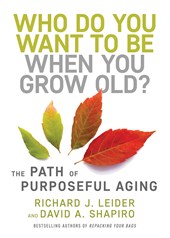Who Do You Want to Be When You Grow Old?: The Path of Purposeful Aging
July 26, 2021
This book urges us to be okay with redefining our ideas of prosperity, success, and happiness as we get older, though there's nothing wrong with being more generous with ourselves and our time when we're young as well.
 Who Do You Want to Be When You Grow Old?: The Path of Purposeful Aging by Richard J. Leider, David Shapiro, Berrett-Koehler Publishers
Who Do You Want to Be When You Grow Old?: The Path of Purposeful Aging by Richard J. Leider, David Shapiro, Berrett-Koehler Publishers
Existing in a society fixated on youthfulness alienates anyone over the age of 23. Even I, at 25, have already felt self-conscious about preventing wrinkles and about what I have or haven't done with my college degree. Reading Thanks for Waiting by Doree Shafrir helped put my mind at ease when it comes to reaching commonplace milestones, and the obstacles that are yet to come is further illuminated by Who Do You Want to Be When You Grow Old? by Richard J. Leider & David Shapiro.
This is a small, slim book that is filled with life-affirming wisdom, applicable to those of any age as we continuously learn about and define ourselves. As the authors put it:
A person can (and should) start growing old well before they start getting old. Living longer requires taking the long view.
Leider and Shapiro teach older people to have patience for themselves and that the insight they provide to the struggles of growing old instills empathy in younger people. It's too easy to allow the divisions between generations, genders, and races to define our social interactions. The authors offer a sensitive look into the very human questions and doubts that goes on in the minds of our elders. It eases my own mind to know that it's not out of the ordinary to continuously reimagine what makes us feel fulfilled, even when we reach an age that many people consider infinitely wise. It makes me realize I've put too much pressure on my only surviving grandparent to give me all the answers to living a fulfilling life. Not only does the book clarify that we are, indeed, all human, all changing, all learning continuously, but it also helps guide us in that learning.
By including a variety of individual and cultural perspectives of aging, the reader can see healthy examples of growing old from across the board: some people don't retire, others leave their jobs but continue to keep busy by taking classes and volunteering, some want to live to 100, while others see 85 as plenty, some struggle with disease, others encounter financial issues, and the hope is that the many years they've all put into life have given them a chance to practice being optimistic about whatever situation they're in. The book asserts that the most important point of the choices you make is that they are your own and not someone else's or the "default choices" that you made in lieu of a riskier choice. The authors share a finding from Leider's workshops with those in the second half of life:
Nearly everyone has considerable issues–not just the usual health and financial challenges of aging, but the types that have persisted for years, that have become themes in people's lives, issues like 'making the best of it,' feeling 'invisible,' the sense of being an 'imposter,' or the fear of having missed out on life's opportunities with no time left to catch up.
Leider finds that these issues often stem from either "place (where they live), people (who they spend their time with), life work (what they do all day, every day), and purpose (why they do what they do)." It's a wakeup call to us all that we should strive to make informed decisions for ourselves, even when they're difficult. And, yet, no matter how hard you try to make the most of your life, there is always internal work to be done.
The book urges us to be okay with redefining our ideas of prosperity, success, and happiness as we get older, though there's nothing wrong with being more generous with ourselves and our time when we're young as well. The short chapters give plenty for readers to think about and share with others, from how to think more positively about aging to the "Three Ultimate Questions" that are part of a discussion about death. It's not all that scary! This is a pocketbook on well-being that is both comprehensive, reflective, and accessible, and I'm happy to have read it sooner rather than later. I’m excited to see what a positive impact it will make on the lives of its older readers.



